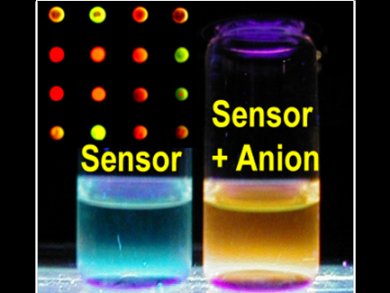Pavel Anzenbacher, Bowling Green State University, Bowling Green, USA, and colleagues are looking for a general guide to developing sensors from known receptors. They have converted the simple receptor calix[4]pyrrole into a fluorescent probe to establish a ratiometric signal. The probe was then incorporated into poly(ether-urethane) hydrogel copolymer matricies to give a sensor array.
The main role of the probe is to bind anions and generate a fluorescence signal output, whereas the primary role of the second component, the polymeric matrix, is to internalize the analyte components. They were able to demonstrate the fluorescent probe could recognize eight different aqueous anions and eight urine samples when embedded in ten different polyurethanes in an array that displays 100 % classification accuracy.
The intrinsic selectivities of the receptor or the polymer matrices on their own are insufficient to result in analytically useful information. However, the conjunction of the intrinsic selectivities of the receptor and the matrix yield unique fingerprint-like patterns that can be successfully harnessed in sensor arrays to analyze anions. Anzenbacher and his team have opened up an avenue for increasing the discriminatory power and resolution in a sensor array by increasing the number of sensor elements using readily available materials.
- Leveraging Material Properties in Fluorescence Anion Sensor Arrays: A General Approach,
P. Anzenbacher, Jr., Y. Liu, M. A. Palacios, T. Minami, Z. Wang, R. Nishiyabu,
Chem. Eur. J. 2013.
DOI: 10.1002/chem.201204188




